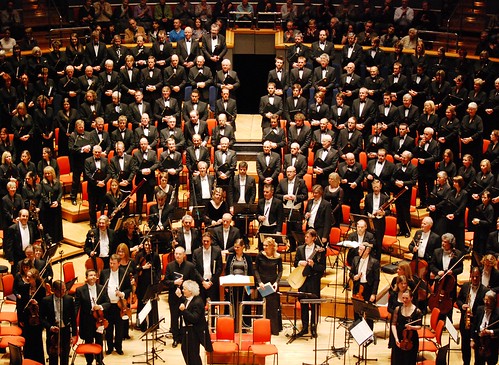Video Preserves Hints of Future For a Director
By ZACHARY WOOLFE
JUST out of Harvard, the director Peter Sellars made his name in the early 1980s with a series of productions of Mozart and Handel operas set in the modern world. The broad outlines of the shows could be easily summarized: “Le Nozze di Figaro” in the Trump Tower, “Così Fan Tutte” in a roadside diner in Massachusetts, “Orlando” in outer space.
Mr. Sellars drew on a fanciful, experimental tradition that had been coursing through America’s theater and new-music scenes for decades but was largely missing from its opera. And he brought to this country — not for the first time but with pathbreaking energy and detail — some of the adventurous spirit of postwar European artists.
But what do you do when your defining work is made before you’re 30? Where to go now that opera directors like Stefan Herheim and Calixto Bieito have taken Sellars-style spectacle to new levels of intellectually charged audacity?
An answer is found in Mr. Sellars’s haunting 2010 staging of Bach’s “St. Matthew Passion” in collaboration with the Berlin Philharmonic and its conductor, Simon Rattle. Released on DVD by the orchestra (at shop.berliner-philharmoniker.de), it shows the director’s gifts pared down to thrilling, focused essentials.
The “Passion” was, of course, never intended by Bach to be staged, and in his characteristically New Age style, Mr. Sellars does not call his spare production — which consists physically of dark clothes, simple gestures and some white blocks — a production. He calls it a ritualization.
There is a slight affectation in this, but it’s true that the work has the quality of a ritual, in which a historical event is experienced as simultaneously past and present, with the performers cast both as observers and participants. This perpetually divided quality is magnified by the way Mr. Sellars, like Jonathan Miller in his street-clothes version of the “Passion,” puts Bach’s split chorus and split orchestra in opposition onstage, making the performers spend long passages simply looking at and listening to each other.
The production was conceived around the immersive architecture of the Philharmonie; with a luxuriously long rehearsal process, the chorus, singers and orchestral soloists were able to memorize their parts — a rarity — and they perform with heart-wrenching immediacy and intimacy. The instrumentalists get tenderly close to the singers during the arias; Judas’s kiss is a stark, daringly extended combination of eroticism and chastity. And when the great bass-baritone Thomas Quasthoff leans his cheek against the tenor Mark Padmore’s during the aria “Gerne will ich mich bequemen” (“Gladly will I submit myself”), it is a gesture of human connection as vivid as any I’ve seen on a stage.
In an interview with Mr. Sellars included on the DVD Simon Halsey, who directed the brilliant Berlin Radio Choir for the performances, said that he had prepared the “St. Matthew Passion” many times in his career, but that this was the first time style was not the primary consideration. By that he meant that this was a production that freed itself from the battles over performance practice that have clogged the world of early music for decades.
Many members of this orchestra and chorus had never done the work; it has become almost solely the province of specialists. Style is crucial, of course, but too often in classical music the how — how many musicians, how large a chorus, how old the instruments — eclipses the why.
There is never any question of why in this performance; every moment seems critical, every note an outpouring. The aesthetic could not be more different from that in Mr. Sellars’s early work, but his vision is the same: an investigation of character and drama with its starting point a fresh understanding of every note in the score.
“Why does it have to be fast and loud and stupid?” he says in the interview with Mr. Halsey, referring to the usually furious choruses featuring the voices of the Jews calling for Jesus’ crucifixion. Instead of anger, in his production those choruses have an uneasy mixture of resentment, guilt and sorrow.
Mr. Rattle is clearly conscious that symphonic interpretations of the “Passion” have been criticized for stolidity and heaviness; he and his magnificent players keep the tempos and textures weighty but always in motion. The female singers are very good — the soprano Camilla Tilling ethereal and the mezzo-soprano Magdalena Kozena impassioned — but the men are tremendous, including the pure-toned tenor Topi Lehtipuu.
The bass-baritone Christian Gerhaher, singing from far above the other performers, is a resonant, otherworldly Jesus. Mr. Padmore is one of the major Evangelists of our time, and he is heartbreakingly eloquent here, less a biblical narrator than a guide through a dark night of the soul. And if it’s possible for this deeply moving recording to take on any more poignancy, it is probably the final major video release featuring Mr. Quasthoff, who in January announced his retirement because of health problems.
It is not, as many have suggested over the years, that you “forget about” or “don’t notice” Mr. Quasthoff’s physical deformity (from thalidomide poisoning) when he sings. You notice it intensely, and his superb performance — including a burning “Mache dich, mein Herze, rein” (“Make thyself, my heart, now pure”), which, as they say, brings it all home — makes very clear Bach’s unmatched gift for presenting both deep hardship and the possibility of transcendence.
Mr. Sellars says in the interview with Mr. Halsey that he sees this “Passion” as a life’s work for him and the Berlin ensemble, and that he hopes to return to it every two or three years, the frequency with which Wilhelm Furtwängler performed it while he led the orchestra. That would be a great gift.
Traducere // Translate
Bach, Rattle & Sellars
Abonați-vă la:
Postare comentarii (Atom)

Niciun comentariu:
Trimiteți un comentariu